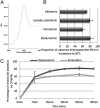Directionally selected cytochrome P450 alleles are driving the spread of pyrethroid resistance in the major malaria vector Anopheles funestus
- PMID: 23248325
- PMCID: PMC3538203
- DOI: 10.1073/pnas.1216705110
Directionally selected cytochrome P450 alleles are driving the spread of pyrethroid resistance in the major malaria vector Anopheles funestus
Abstract
Pyrethroid insecticides are critical for malaria control in Africa. However, resistance to this insecticide class in the malaria vector Anopheles funestus is spreading rapidly across Africa, threatening the success of ongoing and future malaria control programs. The underlying resistance mechanisms driving the spread of this resistance in wild populations remain largely unknown. Here, we show that increased expression of two tandemly duplicated P450 genes, CYP6P9a and CYP6P9b, is the main mechanism driving pyrethroid resistance in Malawi and Mozambique, two southern African countries where this insecticide class forms the mainstay of malaria control. Genome-wide transcription analysis using microarray and quantitative RT-PCR consistently revealed that CYP6P9a and CYP6P9b are the two genes most highly overexpressed (>50-fold; q < 0.01) in permethrin-resistant mosquitoes. Transgenic expression of CYP6P9a and CYP6P9b in Drosophila melanogaster demonstrated that elevated expression of either of these genes confers resistance to both type I (permethrin) and type II (deltamethrin) pyrethroids. Functional characterization of recombinant CYP6P9b confirmed that this protein metabolized both type I (permethrin and bifenthrin) and type II (deltamethrin and Lambda-cyhalothrin) pyrethroids but not DDT. Variability analysis identified that a single allele of each of these genes is predominantly associated with pyrethroid resistance in field populations from both countries, which is suggestive of a single origin of this resistance that has since spread across the region. Urgent resistance management strategies should be implemented in this region to limit a further spread of this resistance and minimize its impact on the success of ongoing malaria control programs.
Conflict of interest statement
The authors declare no conflict of interest.
Figures





References
-
- WHO . Global Plan for Insecticide Resistance Management (GPIRM) Geneva: World Health Organization; 2012.
-
- PMI 2011. President’s Malaria Initiative (PMI): Malaria Operational Plan (MOP) Malawi, Year Six–FY 2012. PMI Report. Available at www.pmi.gov/countries/mops/fy12/malawi_mop_fy12.pdf.
-
- Hargreaves K, et al. Anopheles funestus resistant to pyrethroid insecticides in South Africa. Med Vet Entomol. 2000;14(2):181–189. - PubMed
Publication types
MeSH terms
Substances
Associated data
- Actions
- Actions
- Actions
- Actions
- Actions
- Actions
- Actions
- Actions
- Actions
- Actions
- Actions
- Actions
- Actions
- Actions
- Actions
- Actions
- Actions
- Actions
- Actions
- Actions
- Actions
- Actions
- Actions
- Actions
- Actions
- Actions
- Actions
- Actions
- Actions
- Actions
- Actions
- Actions
- Actions
- Actions
- Actions
- Actions
- Actions
- Actions
- Actions
- Actions
- Actions
- Actions
- Actions
- Actions
- Actions
- Actions
Grants and funding
LinkOut - more resources
Full Text Sources
Medical
Molecular Biology Databases
Miscellaneous

